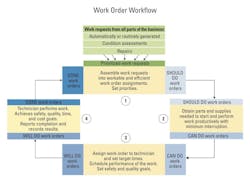Work Order Workflow
A work order system must be more than a way to charge time and cost against a machine. It must be an effective way to plan work and improve efficiency.
If yours is not, you need to think again.
A process plan and schedule will take you from maintenance request to completed work as efficiently as possible. You absolutely must use the work flows inherent in the work order system to enhance rather than hinder efficiency. For equipment fleets, work order systems are—or should be—primarily about managing resources and planning work. The fact that they help to collect cost and machine history comes second.
Efficiency experts have long recognized the importance of the “last planner”: the person who develops workable assignments, makes sure that materials and other required resources are available, and schedules the performance of the work in a logical, efficient manner. There is a lot we can learn from these experts, and, above all, there is a lot we can do to ensure that our work order system fulfills its function as a tool for planning work and improving productivity.
The nearby diagram will help to develop a work order workflow that uses some of the “last planner” concepts and improves both the effectiveness and the efficiency of repair and maintenance operations.
It all starts by having a good system to collect and prioritize repair and maintenance work requests that come in from all parts of the organization. There are three basic types of work requests. First are requests that are automatically or routinely generated to ensure that scheduled maintenance and statutory inspections occur on time. Second are requests based on the condition assessment, inspection, and reporting programs we use to identify necessary repair-before-failure actions. Third are repair requests arising from the critical and unplanned on-shift failures that disrupt production and severely impact our ability to produce completed work on time and on budget.
The process for collecting and prioritizing work requests must be broad and it must work well. Scheduled requests must be identified competently and in a timely fashion; requests based on machine condition must come from superintendents, foremen, and operators as well as from mechanics. All unscheduled repair requests must flow quickly and efficiently through the system and must be communicated immediately to key decision-makers in both equipment and operations so that they can share knowledge and reduce the impact of downtime on production. All work requests—regardless of where they originate—must be classified by type, time stamped, and logged to give data needed to measure reliability and downtime.
Step 1 in the planning process comes when the last planner assembles prioritized work requests into efficient work order assignments and creates a prioritized list of SHOULD DO work orders. Combining a work request for a leaking hydraulic hose on a breaker with a work request for a 250-hour service on the excavator improves efficiency and eliminates another trip to the site. Creating efficient work order assignments and prioritizing these to suit a given situation requires a knowledge of both the equipment and operations side of the business. There is no doubt that work orders requiring the completion of unplanned repair requests must have the highest priority.
Step 2 is critical to the efficiency and success of the process. The last planner makes sure that all parts and supplies needed to start work are available and that the various work requests on a work order can be completed efficiently with minimum interruption. The work order transitions from the theoretical world of the SHOULD DO list to the practical world of the CAN DO list. All the necessary preparatory work must be complete, and the work order should be good to go. Preparing for the work and focusing on what you can do rather than what you should do eliminates many frustrations; wasted trips; and interrupted, inefficient operations.
At Step 3, the work order transitions from CAN DO to WILL DO. Firm commitments are made. First, the last planner must assign the work order to a technician and agree on the target times for completing the work. Second, the performance of the work must be scheduled in cooperation with the job site to ensure minimized impacts on production. Third, safety and quality goals must be set to ensure that the work is managed against clearly defined standards.
In Step 4, WILL DO work orders are communicated to the technician who performs the work, achieves the required safety and quality standards, and records actual start and finish times. The completed (or DONE) work orders are reviewed, closed, and taken off the backlog. Costs are finalized and history is recorded.
It seems complex, but a competent, well understood process converts work requests to completed work orders. The process will provide the key performance indicators required to manage and improve the effectiveness of maintenance operations. Two key metrics are 1) the percentage of repair work requests relative to all repair requests, and 2) repair downtime, defined and measured as the number of work hours lost between the time a repair request is logged and the time the work is completed.
The last planner process emphasizes the planning and the preparatory work needed to improve performance and deliver on commitments. It also provides a framework for managing backlog and ensuring that a steady supply of well planned, prepared, and ready-to-go assignments are available to the technicians that perform the work.
Competent work order management software must be able to support a workflow of this nature. The investment made in software and the time, energy, and effort put into training and deployment is not just about recording machine history and repair cost. It is about improving planning, managing resources, and honoring commitments.
Technicians are skilled individuals, and a key way to support them, acknowledge their skills, and improve productivity is to ensure that work assignments are well thought out and able to be performed with efficiency and pride.
For more asset management, visit the Construction Equipment Executive Institute.
